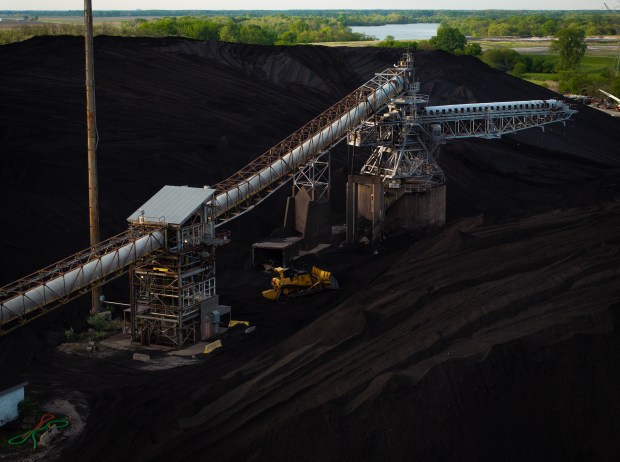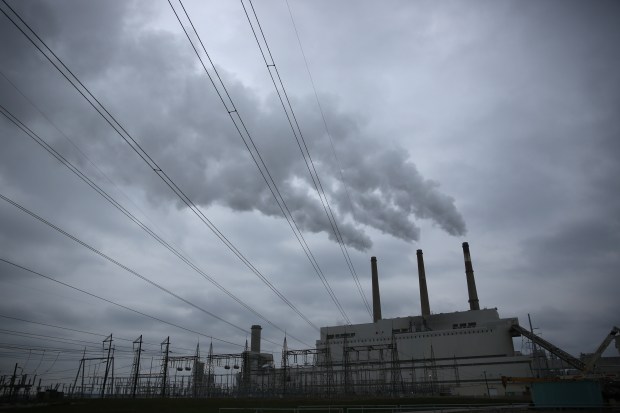For nearly four decades, owners of the Baldwin power plant in southern Illinois managed to avoid the most stringent requirements of the federal Clean Air Act.
The gargantuan coal burner, built during the early to mid-1970s, became the nation’s largest source of sulfur dioxide, which creates acid rain and lung-damaging soot. It also was among the top emitters of climate-changing carbon dioxide, smog-forming nitrogen oxide and brain-damaging mercury.
After Baldwin’s owners kept the Randolph County plant running for years while skipping the installation of modern pollution controls, a 2005 legal settlement with the U.S. Justice Department forced them to begin reducing noxious emissions that contribute to dirty air in Chicago, and other downwind cites as far away as New York.
Yet the coal plant remains one of the biggest polluters in the Midwest.
By 2020, competition from cleaner, less-expensive energy sources prompted the current owner, Houston-based Vistra Corp., to announce it would close Baldwin this year, and retire the rest of its Illinois coal fleet by 2027.
Now Vistra is hedging its decisions.
In November, the company said it would keep Baldwin running until 2027. Then last month, in an attempt to revive the nation’s dwindling coal industry, President Donald Trump threw a lifeline to Vistra and a few dozen other energy companies, encouraging them to apply for exemptions from the latest federal limits on soot, mercury and other toxic air pollution.
Vistra took Trump up on his offer, getting at least a two-year break from tougher regulations at Baldwin and six of its other coal plants: Kincaid south of Springfield, Newton in Jasper County, three in Texas and one in Ohio.
Howard Learner, president and CEO of the nonprofit Environmental Law and Policy Center, noted that regulators during the 1970s exempted dozens of coal plants like Baldwin from the toughest provisions of the Clean Air Act after utilities said they wouldn’t be running much longer. Decades later, Vistra bought its Illinois coal plants betting they could still profit from selling their electricity.
“Like others before them, they’re kicking the can down the road to keep running Baldwin and these other plants as long as they can,” Learner said. “People in Illinois and other Great Lakes states shouldn’t have the suffer the pollution consequences just because President Trump gave them a ‘get-out-of-jail-free’ card.”
Others benefiting from Trump’s exemptions include NRG’s Powerton coal plant near Pekin in Tazewell County, scheduled to close in 2028, and several owned by Southern Company and the Tennessee Valley Authority, two of the biggest energy companies in the Southeast.
Executives at Southern and the TVA already are backing off plans to retire coal plants or extending previously announced closure dates. They have told shareholders they are motivated by opportunities to cash in on a projected need for more electricity to power data centers.
It is unclear whether the Illinois coal plant owners will follow suit. Vistra and NRG told the Chicago Tribune they plan to adhere to previously announced retirement dates.
“But they have an escape hatch that goes all the way up to the president,” said John Walke, a senior clean air attorney at the nonprofit Natural Resources Defense Council. “In our view, President Trump is breaking the law by abusing his authority, which appears to be designed to bide time while his administration attempts to roll back the regulations altogether.”
All told the 69 coal plants Trump exempted from the Mercury and Air Toxics Rule emitted 2,650 pounds of mercury into the atmosphere in 2023, the last year for which federal records are available. The plants accounted for about 10% of all industrial mercury emissions during the period.
Just a teaspoon of the toxic metal can contaminate a 20-acre lake. If certain types of fish are a large part of a mother’s diet, studies have found, mercury passed to her baby in the womb can irreversibly damage the developing brain.
The exempted coal plants also are responsible for nearly half of sulfur dioxide emissions and about a third of nitrogen oxide pollution from the nation’s electricity generators, according to federal records.
Under regulations from former President Joe Biden’s administration, now targeted by Trump and the Republican-controlled Congress, the power plants are required to improve the performance of mercury-reducing equipment, and in some cases upgrade filters that screen soot from billowing out of smokestacks. The more stringent standards effectively limit emissions of other toxics, including benzene, lead and arsenic.
For the first time, coal plant owners must install equipment to constantly measure mercury emissions, similar to what they already do for carbon dioxide, sulfur dioxide and nitrogen oxide.

The U.S. Environmental Protection Agency estimated last year the regulations will provide up to $3 billion in health benefits by 2037, while costing industry up to $330 million.
Republican attempts to roll back the mercury rule and dozens of other environmental regulations come as lower prices for natural gas have prompted many investor-owned companies to abandon coal. Prices for renewable energy have dropped so dramatically that it now costs 45% less to build a new wind farm than operating a coal plant with the same capacity, according to the investment firm Lazard.
During Trump’s first term in office, 79 coal plants closed and 13,000 industry workers lost their jobs. Last year coal plants generated just 15% of the nation’s electricity, the Energy Information Administration reported, down from nearly half in 2011.
Despite economic realities, Trump touts coal as a linchpin of his second-term policies.
“We’re bringing back an industry that was abandoned despite the fact that it was the best, certainly the best in terms of power, real power,” Trump said last month while flanked by coal miners and corporate executives wearing hard hats at the White House.
Though he has said it should be up to states to protect the environment, Trump ordered the Justice Department to target clean energy laws enacted by Illinois and several other states.
“American energy dominance is threatened when state and local governments seek to regulate energy beyond their constitutional or statutory authorities,” Trump said in his missive.
If the Illinois Climate and Equitable Jobs Act survives Trump’s promised legal challenge, the coal plants owned by Vistra and NRG would need to shut down by 2030 at the latest.
Gov. JB Pritzker, a prominent Trump critic, has vowed the president’s actions won’t survive court challenges.
Asked for comment, a Pritzker spokesman directed the Tribune to the governor’s interview last month with David Roberts, a clean-energy podcaster.
“We’re continuing to make progress even now, even with the headwinds that the federal government is putting in our way,” Pritzker told Roberts. “And let’s face it, all of what they’re doing is irrational. It truly makes no sense. We’re creating jobs, we’re growing our economy, in part, based on our focus on climate.”
With the Trump Clean Air Act exemptions, Vistra and NRG would still be able to sell electricity from their coal burners for a few more years without spending more money on pollution controls or improving those already in place. It also is possible they could lobby the Illinois General Assembly to extend the 2030 deadline, a common tactic in Springfield.
The result would be more toxic emissions and climate-changing pollution endangering everyone on the planet.




